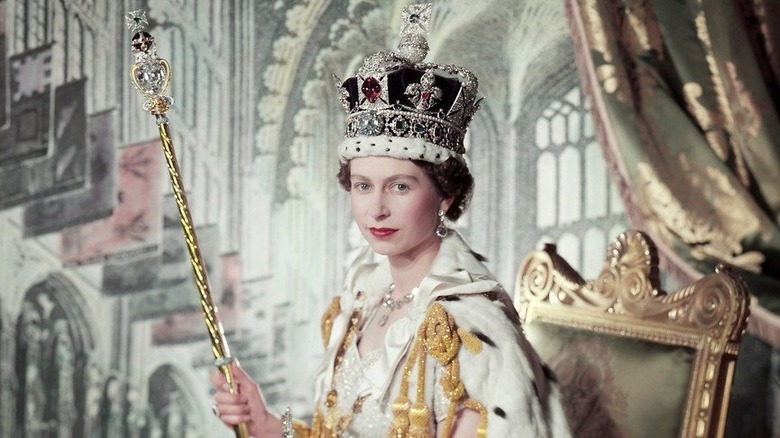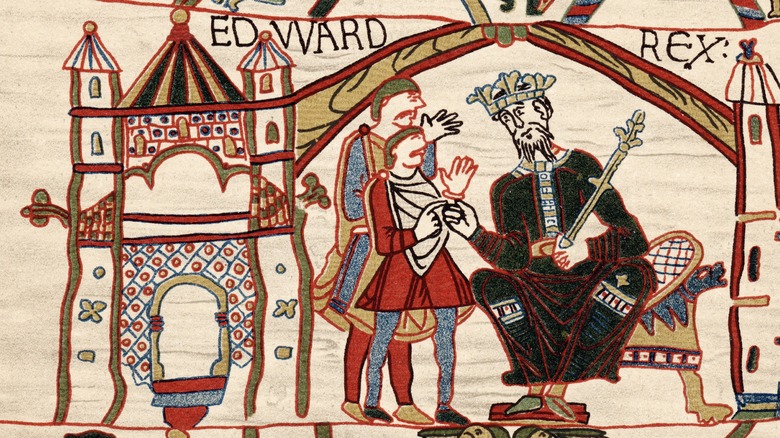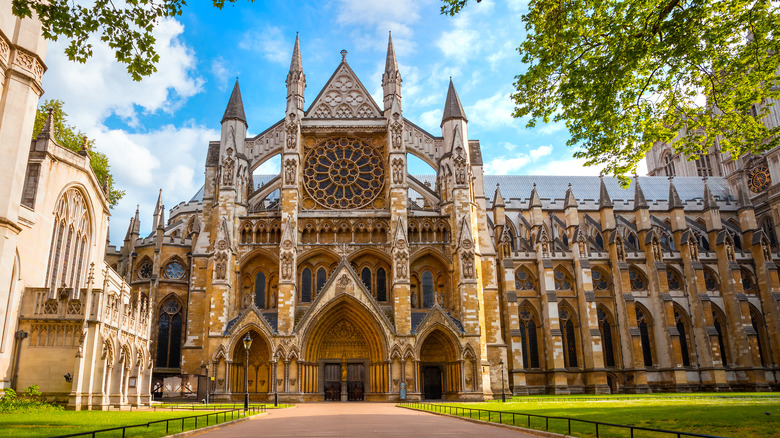What Happened To The Original St. Edward's Crown Of The English Monarchy?
Folks unfamiliar with monarchies might imagine that a king or queen sort of walks around the house with a five-pound crown on their head. Maybe they make a sandwich, head to the toilet, have a nap on the couch, the crown falls on the dog sleeping next to the couch, the dog freaks out, and it's this whole big thing. In reality, monarchs only wear crowns at specific, rare events — we don't want to minimize the impact of seeing a massive crenellation of diamonds, sapphires, pearls, gold, and all that. Besides, as British Heritage quotes the late Queen Elizabeth II, the Imperial State Crown is "unwieldy." She wore it once a year when addressing Parliament.
St. Edward's Crown, however, is worn only once in a monarch's lifetime — at coronation. In a fun little video from 2018, Elizabeth gets reunited with St. Edward's Crown after 65 years. The last time she'd seen it was the first and only time she'd worn it, at her coronation in 1953. That crown (pictured above), however, is a reimagining of an earlier crown. The new St. Edward's Crown, worn only six times by six monarchs over its 360-year life, was crafted for Charles II in 1661. The original was melted down in 1649 following the disastrous reign of Charles I, who did such an odious job that folks apparently couldn't even stand the sight of the crown that touched his head. That original crown, gone forever, is believed to have dated back to the 11th century, according to Historic Royal Places.
Second or third generation headgear
Under normal circumstances, anyone at all can have a look at the current, 360-year-old St. Edward's Crown sitting on a pillow behind glass in the Tower of London. Currently, though, it's out being resized for King Charles III's upcoming May 6 coronation, as The Royal Household discusses. Visitors, however, would pay to remember that the crown is "not a reproduction of the medieval design," as the Royal Collection Trust says, although it does share some design elements with the original: four fleurs-de-lis, two arches, and four crosses-pattée. Looking at the current St. Edward's Crown is like gazing at an altered reflection of the 11th-century original. But even that crown — the one that got tossed in a furnace in 1649 — might not have been the very first crown.
As a blog on the University of Illinois website says, the first written mention of St. Edward's Crown dates to 1220 at the coronation of Henry III, a full 150 years after Edward the Confessor — the guy after whom the crown is named — died in 1066. Edward's crown supposedly passed to William the Conqueror, who after crossing the English Channel from French Normandy lived up to his moniker and became king of England in 1066. But, we've only got pictures to go on for Edward and William's crown connection, specifically The Bayeux Tapestry, an 11th-century comic strip (basically) depicting William the Conqueror's exploits. In it, William's crown kinda-sorta looks like Edward's crown, but there's no way to know for sure.
A holy relic with a messy past
The mystery deepens when we take a look at Edward the Confessor's canonization. Edward became a Catholic saint in 1161, about 400 years before King Henry VIII split from Catholicism and formed his own Christian branch in 1534, the Church of England. That's when people started keeping track of Edward's old crown because it became a holy relic. Specifically, the crown became a "second-class relic," because Edward, a canonized saint, personally owned it, per Treasures of the Church.
The Court Jeweler takes the story from here. Back when Edward was canonized in 1161, monks from Westminster Abbey — the same one that stands in London to this day — got ahold of the relic for safekeeping. They claimed that Edward told them to use the crown for future kings, despite Edward having died one hundred years earlier in 1066. Turns out, the monks lied. The abbey wanted to "to draw pilgrims and patrons to their church" — e.g., tourists — and knew that a holy relic in their possession would do the trick. But since the first written record of Edward's crown comes from 1220, 40 years after Edward's canonization, there's really no way to tell if the crown that the abbey held onto — the one that got melted down in 1649 — was Edward's at all, as it passed to William the Conqueror. At this point, any other crown besides the current St. Edward's Crown remains lost to history or destroyed.


